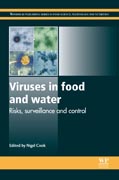
Viruses can be highly infectious and are capable of causing widespread disease outbreaks. The significance of viral pathogens in food and waterborne illness is increasingly being recognised and viruses transferred by these routes are important areas of research. Viruses in food and water reviews the risks, surveillance and control of food and waterborne viral disease.Part one provides an introduction to food and environmental virology. Part two goes on to explore methods of detection, surveillance and risk assessment of viruses in food and water; it includes chapters on molecular detection of viruses in foods and food processing environments, quality control in the analytical laboratory, and quantitative risk assessment for food and waterborne viruses. Part three focuses on virus transmission routes and control of food and water contamination. It contains chapters on fresh produce, shellfish and viral presence, and control methods in waste water and sewage. Finally, part four highlights particular pathogens including norovirus, hepatitis A and emerging zoonotic viruses.Viruses in food and water is a standard reference book for microbiologists in academia, analytical labs and the food and water treatment industries, as well as environmental health professionals and researchers working on foodborne viruses. Explores methods of detection, surveilance and risk assessment of viruses in food and waterConsiders virus transmission routes and control of food and water contaminationHighlights advances in the understanding of specific pathogens, including norovirus, hepatitis A and rotaviruses and the advances in vaccine development INDICE: Part 1 An introduction to food and environmental virology: An introduction to food and waterborne viral disease; Prevalence of viruses in food and the environment. Part 2 Detection, surveillance and risk assessment of viruses in food and water: Molecular detection of viruses in foods and food-processing environments; Sampling strategies for virus detection in foods, food-processing environments, water and air; Molecular detection of viruses in water and sewage; Quality control in the analytical laboratory: Analysing food and waterborne viruses; Tracing the sources of outbreaks of food and waterborne viral disease and outbreak investigation using molecular methods; Quantitative risk assessment for food and waterborne viruses. Part 3 Virus transmission routes and control of food and water contamination: Natural persistence of food and waterborne viruses; Occurrence and transmission of food and waterborne viruses by fomites; Viral contamination by food handlers and recommended procedural controls; Foodborne virus inactivation by thermal and non-thermal processes; Preventing and controlling viral contamination of fresh produce; Preventing and controlling viral contamination of shellfish; Viral presence in waste water and sewage and control methods. Part 4 Particular pathogens and future directions: Advances in understanding of Norovirus as a food and waterborne pathogen and progress with vaccine development; Advances in understanding of Hepatitis A virus as a food and waterborne pathogen and progress with vaccine development; Advances in understanding of rotaviruses as food and waterborne pathogens and progress with vaccine development; Advances in understanding of Hepatitis E virus as a food and waterborne pathogen and progress with vaccine development; Epidemiology, control and prevention of emerging zoonotic viruses; Possible impacts of climate change on viral pathogens in food and water and other emerging issues; Virus indicators for food and water.
- ISBN: 978-0-85709-430-8
- Editorial: Woodhead Publishing
- Encuadernacion: Cartoné
- Páginas: 560
- Fecha Publicación: 10/05/2013
- Nº Volúmenes: 1
- Idioma: Inglés
